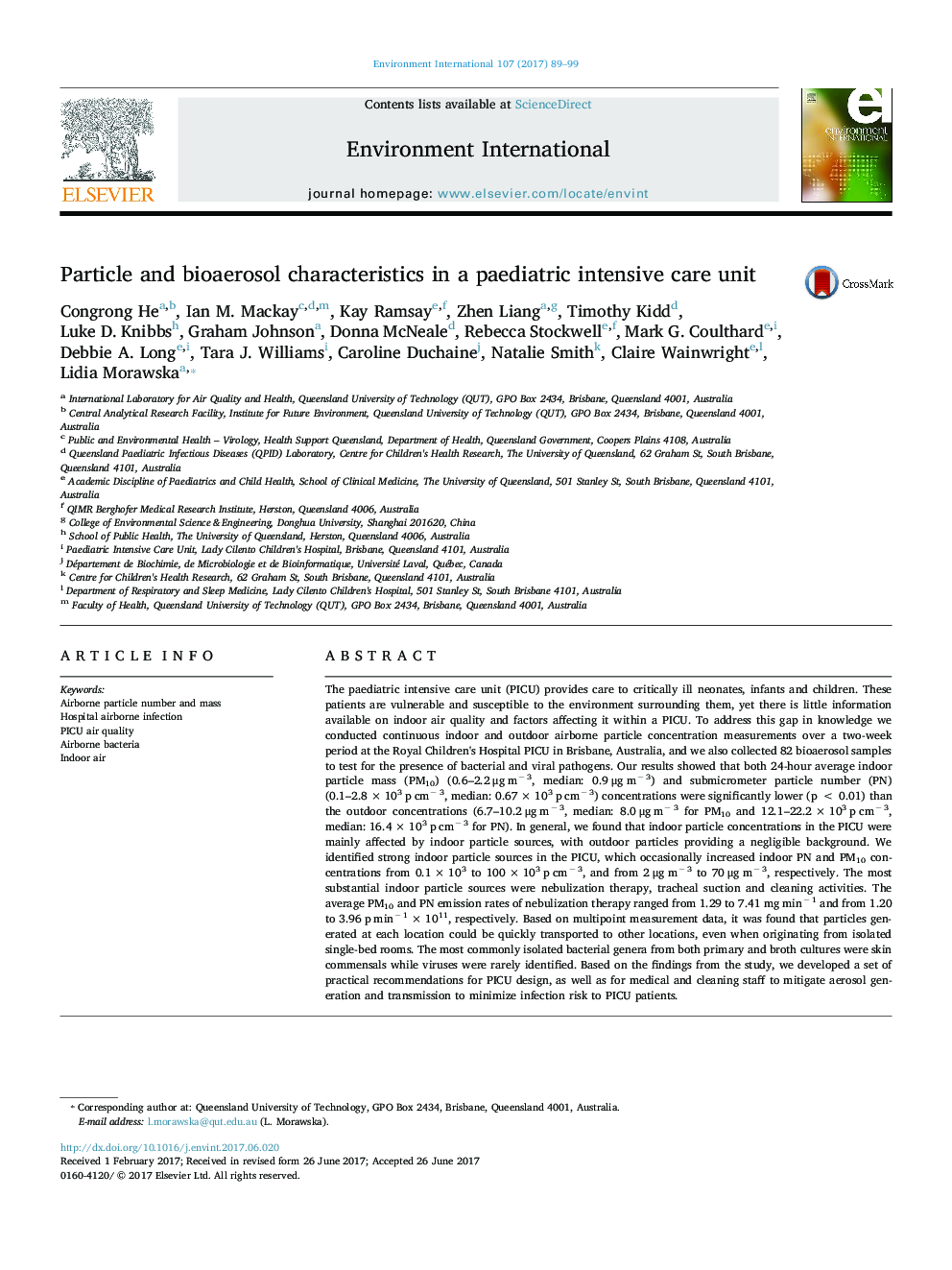| کد مقاله | کد نشریه | سال انتشار | مقاله انگلیسی | نسخه تمام متن |
|---|---|---|---|---|
| 5748308 | 1619023 | 2017 | 11 صفحه PDF | دانلود رایگان |
عنوان انگلیسی مقاله ISI
Particle and bioaerosol characteristics in a paediatric intensive care unit
ترجمه فارسی عنوان
ویژگی های ذرات و بیوآئروسول در واحد مراقبت های ویژه اطفال
دانلود مقاله + سفارش ترجمه
دانلود مقاله ISI انگلیسی
رایگان برای ایرانیان
موضوعات مرتبط
علوم زیستی و بیوفناوری
علوم محیط زیست
شیمی زیست محیطی
چکیده انگلیسی
The paediatric intensive care unit (PICU) provides care to critically ill neonates, infants and children. These patients are vulnerable and susceptible to the environment surrounding them, yet there is little information available on indoor air quality and factors affecting it within a PICU. To address this gap in knowledge we conducted continuous indoor and outdoor airborne particle concentration measurements over a two-week period at the Royal Children's Hospital PICU in Brisbane, Australia, and we also collected 82 bioaerosol samples to test for the presence of bacterial and viral pathogens. Our results showed that both 24-hour average indoor particle mass (PM10) (0.6-2.2 μg mâ 3, median: 0.9 μg mâ 3) and submicrometer particle number (PN) (0.1-2.8 Ã 103 p cmâ 3, median: 0.67 Ã 103 p cmâ 3) concentrations were significantly lower (p < 0.01) than the outdoor concentrations (6.7-10.2 μg mâ 3, median: 8.0 μg mâ 3 for PM10 and 12.1-22.2 Ã 103 p cmâ 3, median: 16.4 Ã 103 p cmâ 3 for PN). In general, we found that indoor particle concentrations in the PICU were mainly affected by indoor particle sources, with outdoor particles providing a negligible background. We identified strong indoor particle sources in the PICU, which occasionally increased indoor PN and PM10 concentrations from 0.1 Ã 103 to 100 Ã 103 p cmâ 3, and from 2 μg mâ 3 to 70 μg mâ 3, respectively. The most substantial indoor particle sources were nebulization therapy, tracheal suction and cleaning activities. The average PM10 and PN emission rates of nebulization therapy ranged from 1.29 to 7.41 mg minâ 1 and from 1.20 to 3.96 p minâ 1 Ã 1011, respectively. Based on multipoint measurement data, it was found that particles generated at each location could be quickly transported to other locations, even when originating from isolated single-bed rooms. The most commonly isolated bacterial genera from both primary and broth cultures were skin commensals while viruses were rarely identified. Based on the findings from the study, we developed a set of practical recommendations for PICU design, as well as for medical and cleaning staff to mitigate aerosol generation and transmission to minimize infection risk to PICU patients.
ناشر
Database: Elsevier - ScienceDirect (ساینس دایرکت)
Journal: Environment International - Volume 107, October 2017, Pages 89-99
Journal: Environment International - Volume 107, October 2017, Pages 89-99
نویسندگان
Congrong He, Ian M. Mackay, Kay Ramsay, Zhen Liang, Timothy Kidd, Luke D. Knibbs, Graham Johnson, Donna McNeale, Rebecca Stockwell, Mark G. Coulthard, Debbie A. Long, Tara J. Williams, Caroline Duchaine, Natalie Smith, Claire Wainwright, Lidia Morawska,
